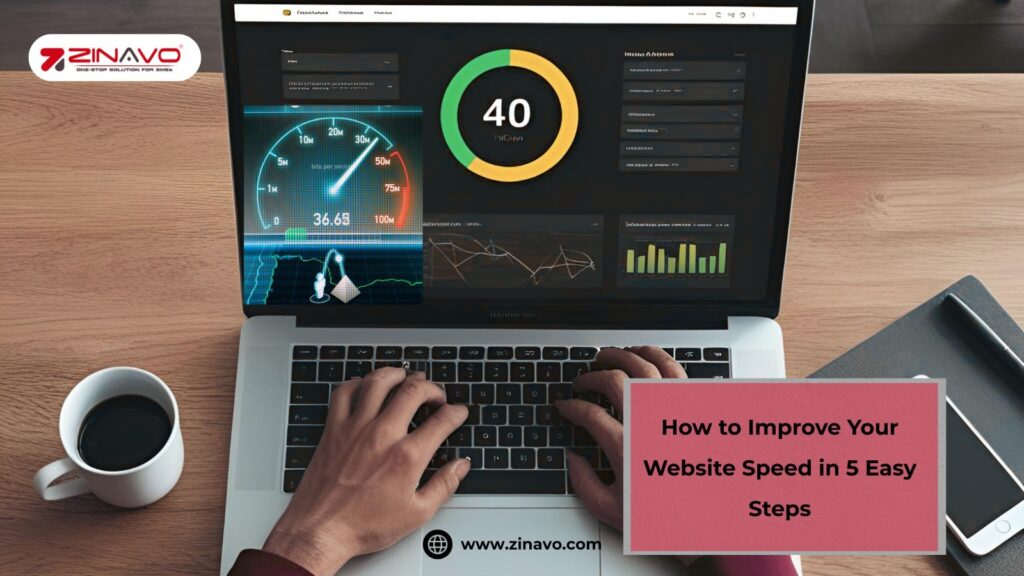How to Improve Your Website Speed in 5 Easy Steps?
Introduction:
The speed of a website is one of the most important factors for its success online. You will be able to keep visitors on your website for longer, improve your SEO rankings, and increase sales with a fast-loading website.. Whether you have a business website, a blog, or an eCommerce store, improving your website speed should be a top priority.
In this guide, we’ll explain how to boost your website’s speed using five simple and effective steps. These steps are easy to follow and work for beginners, developers, and business owners.
- Optimize your images
- Use fast hosting
- Enable browser cachin
- Minify your website code
- Reduce heavy plugins
Why Website Speed Matters
Before we dive into the steps, let’s understand why website speed is so important:
- Better user experience: People don’t like waiting. A fast site makes users happy.
- Higher rankings: Google prefers websites that load faster.
- More sales: A quicker site means more customers and better conversion rates.
- Lower bounce rates: Visitors stay longer if your pages load quickly.
Step 1: Optimize Your Images
Websites that are slow are often caused by large images. Optimizing them can make a big difference in loading time.
What to do:
- Resize images: Don’t upload a 3000px wide image if you only need 600px.
- Compress images: To reduce the size of images, use tools such as TinyPNG or [ImageOptim].
- Use modern formats: Try using WebP format for images—it’s smaller and loads faster.
Step 2: Use a Fast and Reliable Hosting Provider
Your web hosting service plays a big role in how fast your website loads. Cheap or shared hosting can slow down your site, especially if many websites share the same server.
What to do:
- You should choose a hosting provider that is known for its speed and reliability.
- If you are running a WordPress website, you should consider cloud hosting or managed WordPress hosting.
- Use CDN (Content Delivery Network) services like Cloudflare to speed up content delivery around the world.
Pro Tip:
Look for hosting with SSD storage, fast server response time, and 24/7 customer support.
Step 3: Enable Browser Caching
Browser caching saves some files (like images, CSS, and JavaScript) on a visitor’s browser. This way, the next time they visit your site, it loads faster.
What to do:
- Add caching rules to your .htaccess file (for Apache servers).
- Use plugins like WP Rocket, W3 Total Cache, or LiteSpeed Cache if you’re using WordPress.
Pro Tip:
You can test if browser caching is working with tools like GTmetrix or Pingdom.
Step 4: Minify CSS, JavaScript, and HTML
Minifying removes spaces, comments, and unnecessary characters from your website code. Your files will be smaller and will load more quickly as a result.
What to do:
- Use tools like Minifier, UglifyJS, or CSSNano.
- If using WordPress, use plugins like Autoptimize or Fast Velocity Minify.
- Combine small CSS and JS files to reduce the number of HTTP requests.
Pro Tip:
Be careful when minifying—always back up your site before making changes.
Step 5: Reduce the Use of Heavy Plugins and External Scripts
Too many plugins or external scripts (like ads, chat boxes, or tracking codes) can slow your site significantly.
What to do:
- Remove plugins you don’t use or need.
- Use lightweight alternatives to heavy plugins.
- Load scripts like YouTube videos or Google Maps only when needed (lazy loading).
- Avoid too many font styles or third-party widgets.
Pro Tip:
Use performance analysis tools to find which plugins are slowing down your site.
Bonus Tips
Here are a few extra tricks to make your website even faster:
- Use lazy loading for images and videos.
- Enable Gzip compression on your server.
- Limit redirects as they add extra loading time.
- For improved performance and security, keep your CMS, themes, and plugins up-to-date.
- Optimize your database regularly, especially if you run a blog or eCommerce store.
Speed Comparison Table
| Task | Impact on Speed | Difficulty | Recommended Tool/Plugin |
| Image optimization | High | Easy | TinyPNG, WebP, ImageOptim |
| Fast hosting | Very High | Easy | Bluehost, SiteGround, Cloudways |
| Browser caching | Medium | Medium | WP Rocket, W3 Total Cache |
| Minifying code | Medium | Medium | Autoptimize, Minifier |
Conclusion
Website speed matters more than ever in 2025. It affects everything—from your search engine rankings to your customer satisfaction and conversion rates.
By following these 5 easy steps:
- Optimize your images
- Use fast hosting
- Enable browser caching
- Minify your website code
- Reduce heavy plugins
You’ll significantly improve your site’s performance. Remember, you don’t need to be a developer to make your website faster. Just take it one step at a time, use the right tools, and always keep testing your site’s speed.
A faster website means happier visitors and more success for you!
Frequently Asked Questions
- Optimize images
- Choose fast and reliable hosting
- Enable browser caching
- Minify CSS, JavaScript, and HTML
- Remove unnecessary plugins or scripts



